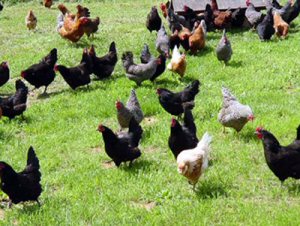Ashleigh Bright
 Public debate has stimulated the call for more animal-friendly, alternative housing systems for laying hens (e.g. aviaries, percheries, free range). The EU has issued a directive banning the battery cage as from 2012. However, the increased risk of feather pecking is a major obstacle to the widespread adoption of alternative housing systems. Feather pecking (FP) consists of pecking and/or pulling at the feathers of other birds. In addition to the animal welfare issues associated with feather pecking, there are important commercial considerations in terms of lost productivity and increased mortality. Remedial measures currently practiced by the poultry industry have associated welfare problems. For example, beak trimming, which involves partial amputation of the beak, is widely practiced. However, beak trimming causes pain both during and after the operation. FP is also reduced by keeping birds under dim light but this practice impoverishes the visual environment and it can cause eye abnormalities. The development of alternative systems for layers that minimize the risk of FP without resort to beak trimming are a priority for the egg industry. Public debate has stimulated the call for more animal-friendly, alternative housing systems for laying hens (e.g. aviaries, percheries, free range). The EU has issued a directive banning the battery cage as from 2012. However, the increased risk of feather pecking is a major obstacle to the widespread adoption of alternative housing systems. Feather pecking (FP) consists of pecking and/or pulling at the feathers of other birds. In addition to the animal welfare issues associated with feather pecking, there are important commercial considerations in terms of lost productivity and increased mortality. Remedial measures currently practiced by the poultry industry have associated welfare problems. For example, beak trimming, which involves partial amputation of the beak, is widely practiced. However, beak trimming causes pain both during and after the operation. FP is also reduced by keeping birds under dim light but this practice impoverishes the visual environment and it can cause eye abnormalities. The development of alternative systems for layers that minimize the risk of FP without resort to beak trimming are a priority for the egg industry.

Despite nearly 40 years of research on the topic, no single causal factor for FP has been identified, and there is growing acceptance that the development of FP represents a multi-factorial process. Because only limited conclusions and relevance to the industry can be drawn from small-scale studies, the focus of this research project is on commercial laying flocks. The UK's largest egg producing company, has organised farms (rearing and laying), which allow me to regularly monitor their free-range flocks. The University also has a commercially run Food Animal Initiative (FAI) farm at the Wytham Field Station, which is being used for pilot and experimental studies. The basic approach of the project is to continuously monitor a wide range of variables under a variety of commercial conditions to identify factors and combinations of factors that may be used to predict precursors of stress in commercial flocks.
The first objective of the project is to develop appropriate protocols and methods for on-farm monitoring, in particular a method of non-intrusive feather scoring. The second objective is to carry out longitudinal
monitoring of approximately 20 commercial flocks. Finally, I am carrying
out small scale short-term studies to test predictions arising from the commercial study. |

